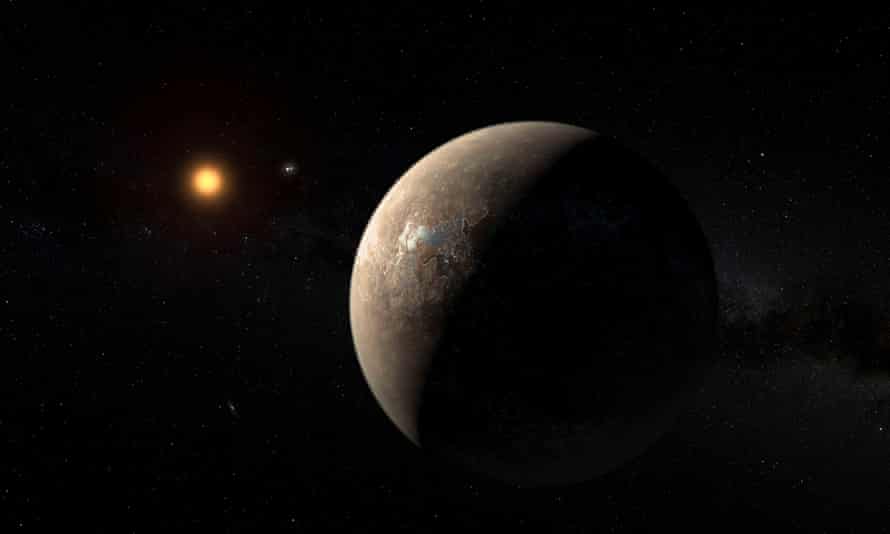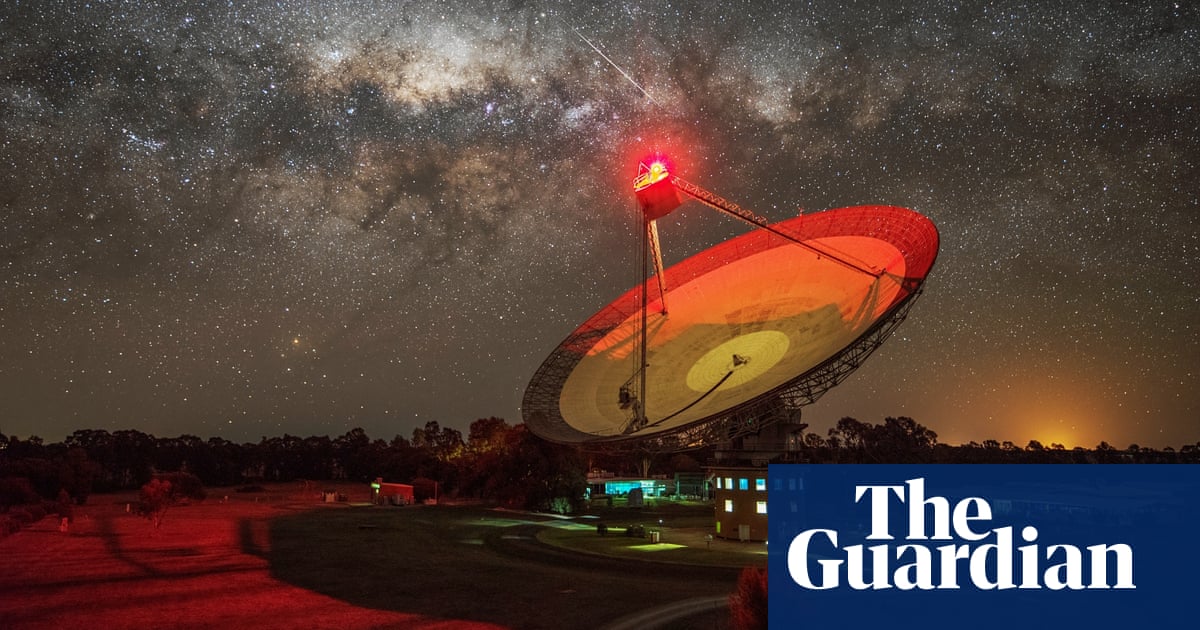Astronomers behind the most extensive search yet for alien life are investigating an intriguing radio wave emission that appears to have come from the direction of Proxima Centauri, the nearest star to the sun.
The narrow beam of radio waves was picked up during 30 hours of observations by the Parkes telescope in Australia in April and May last year, the Guardian understands. Analysis of the beam has been under way for some time and scientists have yet to identify a terrestrial culprit such as ground-based equipment or a passing satellite.
It is usual for astronomers on the $100m (£70m) Breakthrough Listen project to spot strange blasts of radio waves with the Parkes telescope or the Green Bank Observatory in West Virginia, but all so far have been attributed to human-made interference or natural sources.
The latest “signal” is likely to have a mundane explanation too, but the direction of the narrow beam, around 980MHz, and an apparent shift in its frequency said to be consistent with the movement of a planet have added to the tantalising nature of the finding. Scientists are now preparing a paper on the beam, named BLC1, for Breakthrough Listen, the project to search for evidence of life in space, the Guardian understands.
The beam that appears to have come from the direction of Proxima Centauri, a red dwarf star 4.2 light years from Earth, has not been spotted since the initial observation, according to an individual in the astronomy community who requested anonymity because the work is ongoing. “It is the first serious candidate since the ‘Wow! signal’,” they said.
The “Wow! signal” was a short-lived narrowband radio signal picked up during a search for extraterrestrial intelligence, or Seti, by the Big Ear Radio Observatory in Ohio in 1977. The unusual signal, which gained its name after astronomer Jerry Ehman wrote “Wow!” next to the data, unleashed a wave of excitement, though Ehman cautioned about drawing “vast conclusions from half-vast data”.

Launched in 2015 by Yuri Milner, a science and technology investor based in Silicon Valley, the Breakthrough Listen project eavesdrops on the million stars closest to Earth in the hope of detecting stray or intentional alien broadcasts. The 10-year effort was announced at the Royal Society in London when the late Stephen Hawking called the work “critically important”. Speaking at the event, Hawking, who saw humanity’s future in the stars, said: “Mankind has a deep need to explore, to learn, to know. We also happen to be sociable creatures. It is important for us to know if we are alone in the dark.”
The challenge for astronomers on Breakthrough Listen, and others devoted to finding intelligent life in the heavens, is to spot potential “technosignatures” among the relentless babble of radio waves from equipment on Earth, natural cosmic phenomena, and orbiting hardware that circles the planet. It is no easy task. In 1997 the US alien hunter Jill Tarter, who inspired the character of Ellie Arroway in the movie Contact, detected a potential signal but it was later found to be broadcasts from an antenna on the Soho spacecraft, a joint mission to observe the sun by Nasa and the European Space Agency.
Though too faint to be seen with the naked eye, Proxima Centauri has come under intense scrutiny from astronomers. At least two planets are known to orbit the star. One is a gas giant and the other is believed to be a rocky world about 17% more massive than Earth. Known as Proxima b, the planet circles its star every 11 days and lies in the so-called “habitable zone”, where the temperature is right for water to flow and pool.
But that does not mean water is present on Proxima b. Despite its apparently cosy location, the planet may well be hostile to life. In 2017, Nasa scientists used computer models to show that if Proxima b had an Earth-like atmosphere, it could easily be stripped away by the intense radiation and solar flares unleashed by its parent star. Under this battering, the 4bn-year-old planet could have lost its entire atmosphere in 100m years.
Pete Worden, the former director of Nasa’s Ames Research Center in California and executive director of the Breakthrough Initiatives, said it was important to wait and see what the project’s scientists concluded: “The Breakthrough Listen team has detected several unusual signals and is carefully investigating. These signals are likely interference that we cannot yet fully explain. Further analysis is currently being undertaken.”
Others are cautious, to say the least. “The chances against this being an artificial signal from Proxima Centauri seem staggering,” said Lewis Dartnell, an astrobiologist and professor of science communication at the University of Westminster. “We’ve been looking for alien life for so long now and the idea that it could turn out to be on our front doorstep, in the very next star system, is piling improbabilities upon improbabilities.
“If there is intelligent life there, it would almost certainly have spread much more widely across the galaxy. The chances of the only two civilisations in the entire galaxy happening to be neighbours, among 400bn stars, absolutely stretches the bounds of rationality.”
It is not only the statistics that look bad. Proxima b is so close to its parent star that it is tidally locked, like the moon is to the Earth. One side is eternal day, the other in perpetual darkness. “It’s hard to imagine how you can have a stable climatic system and all the things you need to get from bacteria, which are hardy, up to intelligent animal life forms, which certainly are not,” Dartnell added. “But I’d love to be proved wrong.”
Is there anybody out there?
1899 The search for life elsewhere has been long and profoundly unproductive, at least in terms of trying to find alien civilisations. At the end of the 19th century, the Serbian-American inventor Nikola Tesla believed he had intercepted radio messages from Mars. As far as scientists know from countless observations and decades of visits by robotic probes, there is no life on Mars.
1967 The astrophysicist Dame Jocelyn Bell Burnell was poring over a mountain of data from a new radio telescope she had helped to build when she spotted an unusual signal. It was faint but repeating steadily. After ruling out interference from Earthly sources, the team considered little green men. The real source turned out to be a pulsar, a spinning neutron star that emits beams of radio waves like a heavenly lighthouse.
1977 It happened to be the year Star Wars was released when Jerry Ehman, an astronomer at Ohio State University’s Big Ear radio telescope, found something curious while scanning the heavens for alien broadcasts. The telescope was observing a group of stars called Chi Sagittarii when it recorded a 72-second pulse of radio waves. Ehman circled the data and wrote “Wow!” on the readout, giving the signal its name. Scientists have proposed possible sources but the signal remains unexplained.
2003 The Seti@home project, run by the University of California in Berkeley with observations from the Green Bank radio telescope and the recently collapsed Arecibo telescope, also discovered an intriguing signal. The 1420MHz burst of radio waves, known as SHGb02+14a, was observed three times before vanishing. The signal lies in the “water hole” quiet zone of the electromagnetic spectrum, which scientists consider an attractive band for alien civilisations to broadcast interstellar signals.
